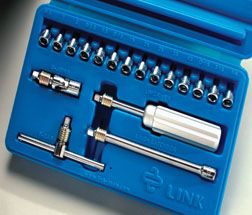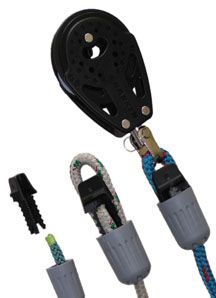
Link Trims Tool Set Price, Size
Three and a half years ago, in the Chandlery column, Practical Sailor introduced to readers a then-new set of spare-no-expense tools made by a company called Link, which seems to be the source of many fine tools.
The 41-piece tool set was included in a PS review of 10 products deemed outstanding published Oct. 1. It was a complete ¼-inch socket set and included some screwdriver bits.
The set was not cheap ($250 list), but sailors frequently want something they can depend on forever.
Now, Link has put together a more modest set ($160 list). The 18-piece kit is basically a ¼-inch ratcheting screwdriver and T-bar set, with 14 screwdriver bits to fit any screw you may encounter—slotted, Phillips, square drive, hex, torx, or star. Included in the boxed kit are a T-bar, extender, and U-joint.
Every piece is equipped with Link’s patented locking mechanism, a casehardened pin actuated by a spring-loaded collar. It simply will not let go, so the tip won’t come off and drop in the bilge.
These Link tools are made entirely of high-grade steel plated with nickel and highly polished chrome. (A metallurgist friend once explained that properly done chrome is the most enduring and perfect of all finishes.)
You can pick and choose from a selection of other tool kits in Link’s interesting catalog.
Contact – Link Tools, 773/248-5853, www.link-tools.com.

———-
Nuts over Splicing?
Small-boat owners who’d rather not eye-splice or tie a bowline in braided line now have another option: the Splicing Nut from InoDesign. Practical Sailor has not yet tested this device, but we intend to put it to use, and we are interested in receiving feedback on the product.
According to InoDesign, a quarter-inch Splicing Nut has a maximum load capacity of 1,000 pounds and a recommended working load of 400 pounds. To put this into perspective, consider that New England Rope’s quarter-inch Sta-Set braided nylon line carries a tensile strength of 2,200 pounds, and a very conservative calculated safe working load of 156 pounds (using the Cordage Institute’s formula). A bowline in that line can reduce the tensile strength by up to 33 percent, leaving it at 1,474 pounds; an eye splice will reduce it by only 10 percent or less. InoDesign says the nut has roughly the same effect on a line’s tensile strength as a bowline.
It does take a fair amount of torque to twist Splicing Nut’s two parts together, and a little practice is needed to master the assembly, but most sailors should be able to create an attachment loop in the line in less than 60 seconds.
The real advantage of a Splicing Nut is that it takes the place of a splice but can be easily undone and reused. Also, the nut will serve as a stop to keep halyard shackles from jamming in a sheave when over-tensioned or sheets from catching on standing rigging.
What’s the downside? The devices are relatively heavy compared to a dry eye splice or knot, and the two largest sizes are somewhat bulky. The Splicing Nut is sold in four sizes (3/16 inch, ¼ inch, 5/16 inch, and 3/8 inch) and prices range from $12.95 for two 3/16-inch nuts to $24.95 for four 3/8-inch nuts.
Contact – Inodesign, 206/403-8884, www.splicingnut.com.



































